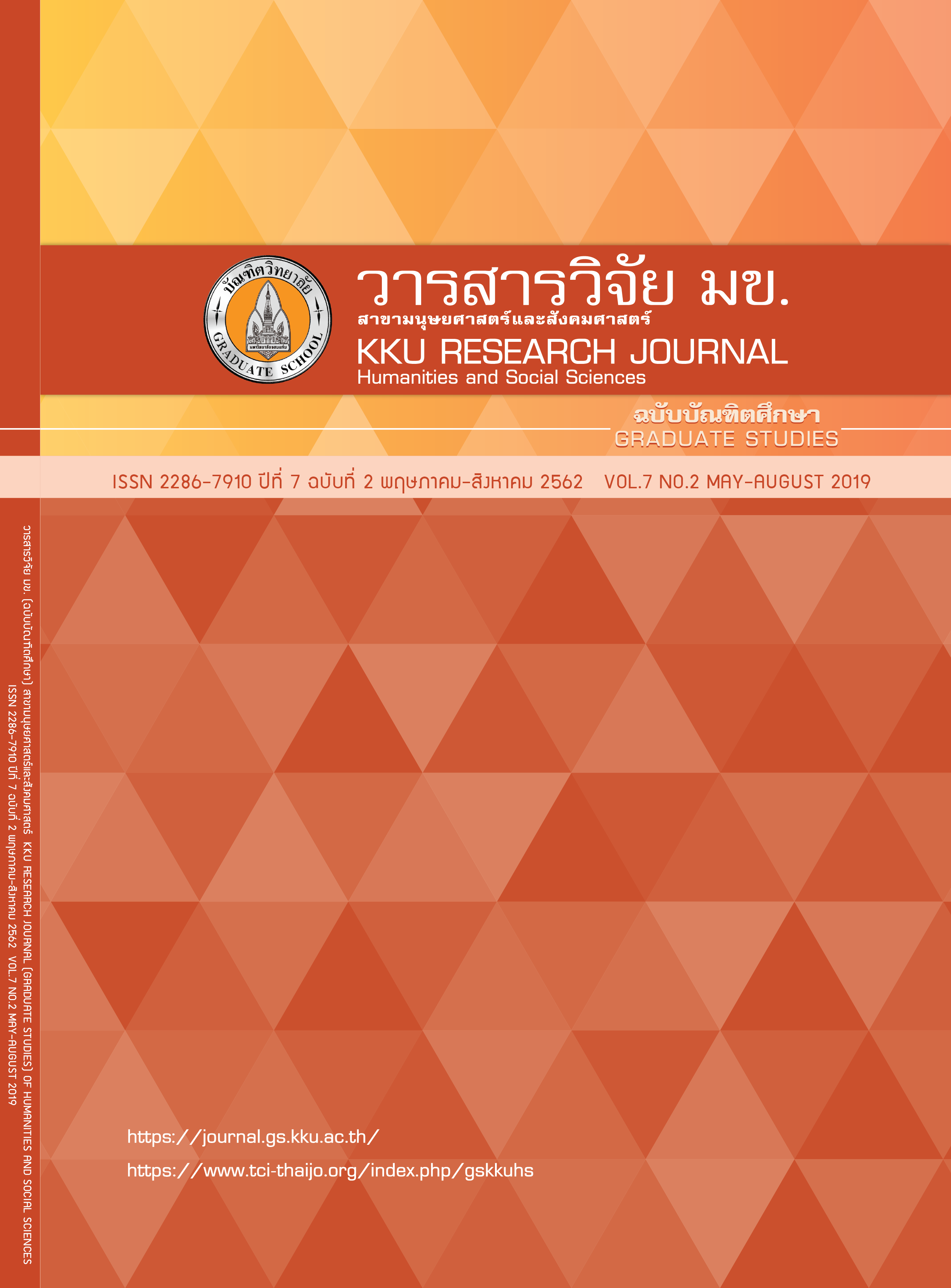รูปแบบการเรียนการสอนภาษาอังกฤษด้วยการเรียนรู้แบบผสมผสาน เพื่อส่งเสริมทักษะการสื่อสาร
คำสำคัญ:
การสอนภาษาอังกฤษ, การเรียนรู้แบบผสมผสาน, รูปแบบการจัดการเรียนการสอนบทคัดย่อ
การวิจัยนี้มีวัตถุประสงค์เพื่อศึกษาผลการใช้รูปแบบการเรียนการสอนที่พัฒนาขึ้นในการส่งเสริมทักษะการสื่อสาร การวิจัยนี้ดำเนินการตามกระบวนการวิจัยและพัฒนา ซึ่งรูปแบบการเรียนการสอนที่พัฒนาขึ้นมี 5 องค์ประกอบ ได้แก่ 1) Orientation to the Model 2) Model of Teaching 3) Application 4) Instructional and Nurturant Effects 5) Assessment and Evaluation และนำรูปแบบไปทดลองใช้ในระยะวิจัยที่ 3 กับนักศึกษาที่ลงทะเบียนเรียนรายวิชาภาษาอังกฤษ 1 ประจำภาคการศึกษาที่ 2 ปีการศึกษา 2559 มหาวิทยาลัยแม่ฟ้าหลวง จังหวัดเชียงราย จำนวน 42 คน 2 กลุ่มเรียน ซึ่งจัดกลุ่มด้วยการสุ่มอย่างง่าย คือ กลุ่มทดลอง มีผู้เรียน 26 คน ซึ่งจัดการเรียนการสอนด้วยรูปแบบที่พัฒนาและระบบการจัดการเรียนรู้ CANVAS เพื่อเสริมการเรียนรู้ในชั้นเรียน และกลุ่มควบคุมมีผู้เรียน 16 คน ซึ่งจัดการเรียนการสอนด้วยรูปแบบปกติ สถิติที่ใช้คือค่าเฉลี่ย ส่วนเบี่ยงเบนมาตรฐาน และ t-test ผลการวิจัยพบว่า ผู้เรียนกลุ่มทดลองมีคะแนนเฉลี่ยภาษาอังกฤษแตกต่างจากผู้เรียนกลุ่มควบคุมอย่างมีนัยสำคัญทางสถิติที่ระดับ .01
เอกสารอ้างอิง
Policies on Teaching English [Internet]. 2014. [updated 2018, cited 2015 Feb 15].
Available from: http://english.obec.go.th/english/2013/index.php/th/2012-08-
08-10-26-5/62-2014-04-24-10-26-10
2. Boonpatanaporn P. Thai Students’ English Proficiency and the New World of AEC.
University of the Thai Chamber of Commerce Journal; Humanities and Social Sciences,
32(3), 214-228. 2012. Thai.
3. Office of the Higher Education Commission. The 11th Higher Educational
Development Plan (2012-2016) [Internet]. 2013. [updated 2018, cited 2015 Feb 15].
Available from: http://www.mua.go.th/users/bpp/developplan/download/higher_edu_
plan/PlanHEdu11_2555-2559.pdf
4. Kongsema K. Problems of Teaching English in Thailand. Research and
Development Journal, Loei Rajabhat University. 2011; 6(17): 73-86. Thai.
5. Noparat T. Use of Facebook Group as Blended Learning and Learning
Management System in Writing. 2014. Teaching English with Technology,
14(3). 3-15.
6. Supharatypthin D. Developing students’ ability in listening and speaking
English using the Communicative Approach of teaching. 2014.
International Journal of Arts & Sciences, 7(3), 141-149.
7. Uttawet P. Development of a Remedial English Course Using Multimedia to
Enhance English Proficiency and Learning Motivation of Low English Proficiency
Students. STOU Education Journal. 2014; 7(2): 127-140. Thai.
8. Richards J C, Rodgers T. Approach and Method in Language Teaching.
3rd ed. New York: Cambridge University Press. 2014.
9. Richards J C. Communicative Language Teaching Today. New York:
Cambridge University Press. 2006.
10. Angkawattanakul S. Teaching English as a Foreign Language. Bangkok:
Chulalongkorn University Press. 1992. Thai.
11. Greenberg B, Horn M. [Speakers]. Blended Learning [Online Video
Streaming]. 2015. [updated 2018, cited 2015 September 1]. Available from:
https://www.khanacademy.org/partner-content/ssf-cci
12. Staker H, Horn B. Classifying K-12 Blended Learning. 2012.
[updated 2018, cited 2015 October 29]. Available from
http://www.christenseninstitute.org/wp-content/uploads/2013/04/
Classifying-K-12-blended-learning.pdf
13. Patrick S, Kennedy K, Powell A. Mean What You Say: Defining and
Integrating Personalized, Blended and Competency Education [Internet].
2013. [updated 2015, cited 2015 October 29]. Available from:
http://www.inacol.org/wp-content/uploads/2015/02/mean-what-you-say.pdf
14. Hsiu-Ting Hung. Flipping the classroom for English language learners to
foster active learning. Computer Assisted Language Learning. 2015.
[updated 2017, cited 2015 November 5]. Available from:
http://www.tandfonline.com/doi/full/10.1080/09588221.2014.967701
15. Richey C, Klein D. Design and Development Research. New York:
Routledge. 2007.
16. Safranj J. Using Information Technology in English Language Learning
Procedure: Blended Learning. Procedia- Social and Behavioral Sciences.
2013; 83: 514-521. [updated 2018, cited 2015 September 18]. Available from
https://www.sciencedirect.com/science/article/pii/S187704281301166X
17. Sahin-Kizil A. Blended instruction for EFL learners: Engagement,
learning and course satisfaction. The JALT CALL Journal. 2014; 10(3):
175-188. [updated 2018, cited 2015 September 18]. Available from
https://eric.ed.gov/?id=EJ1107909
18. Bataineh R F, Mayyas M B. The Utility of Blended Learning in EFL
Reading and Grammar: A Case for Moodle. Teaching English with
Technology, 17(3). 35-49. 2017
19. Kwangsawad T. Teaching English Through Technology. Bangkok:
Chulalongkorn University Press. 2014. Thai.




